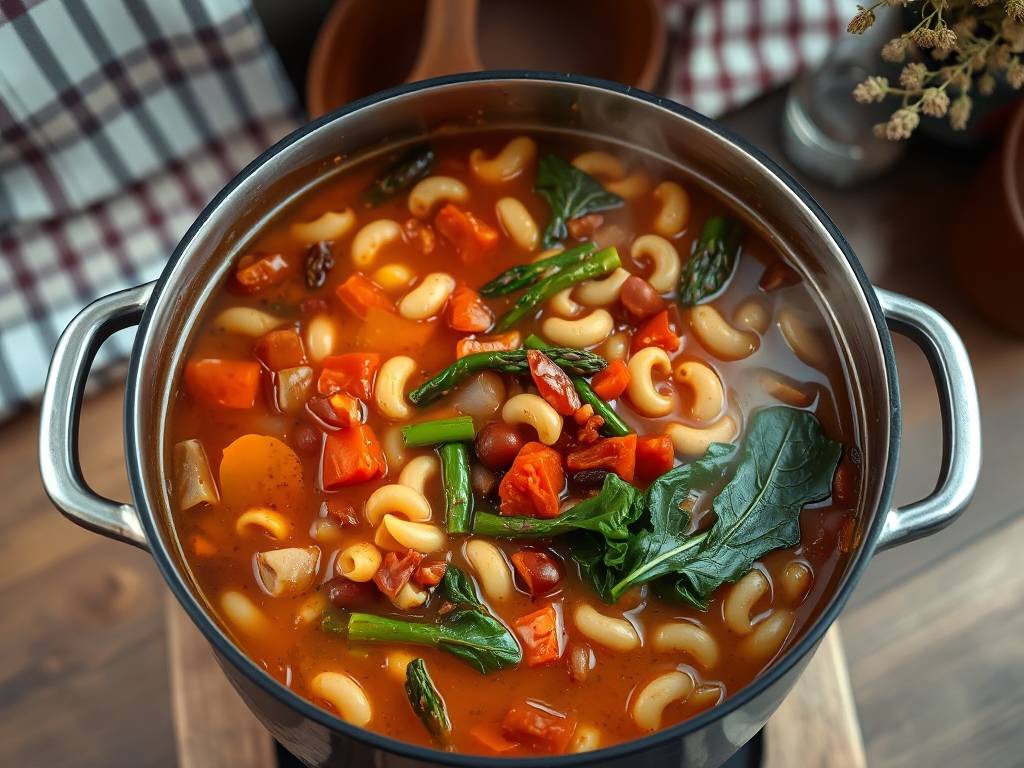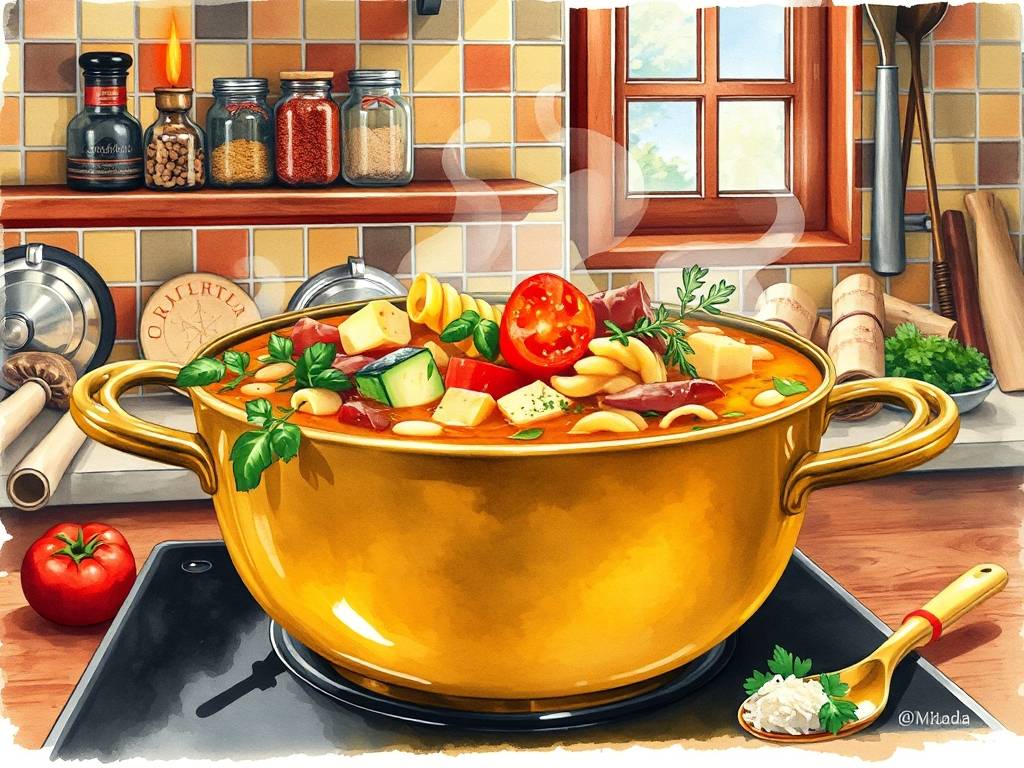The Art of Crafting Authentic Italian Minestrone Soup
Minestrone soup represents the heart and soul of Italian home cooking—a rustic, nourishing dish that transforms humble ingredients into something truly extraordinary. This classic Italian vegetable soup varies by region and season, but always maintains its characteristic hearty texture and deep, savory flavors. Making authentic minestrone isn't just about following a recipe; it's about understanding the philosophy behind Italian cooking: respect for quality ingredients and allowing their natural flavors to shine.
The Foundation: Building Flavor from the Bottom Up
Every great minestrone begins with a solid flavor foundation. Traditional Italian cooking starts with soffritto—a mixture of finely chopped onions, carrots, and celery slowly sautéed in high-quality olive oil. This holy trinity of Italian cuisine forms the aromatic base that will carry the entire soup.
Begin with ¼ cup of extra virgin olive oil in a heavy-bottomed pot over medium heat. Add one finely chopped yellow onion, two diced carrots, and two diced celery stalks. The key here is patience—cook them slowly for 8-10 minutes until they become soft and fragrant but not browned. This gentle cooking process allows the vegetables to release their natural sugars, creating a sweet, complex base for your soup.

Many authentic recipes include pancetta or guanciale diced and rendered with the soffritto. For a vegetarian version, simply omit the pork products—the vegetables provide plenty of flavor on their own. Season with a pinch of salt at this stage to help draw out the moisture and enhance the vegetables' natural flavors.
The Heart of the Matter: Beans and Vegetables
The beauty of minestrone lies in its versatility. While recipes vary, certain elements remain constant. Beans provide protein and substance, making the soup a complete meal. Classic choices include cannellini beans, borlotti beans, or chickpeas. For the most authentic flavor, use dried beans soaked overnight and cooked separately, though quality canned beans work well for convenience.
Drain and rinse two cups of cooked cannellini beans, reserving about a cup to puree later. This technique creates a naturally creamy texture without dairy. The remaining whole beans will maintain their shape and provide pleasant texture contrasts.
For vegetables, think seasonally. In winter, use sturdy vegetables like cabbage, potatoes, and kale. Summer versions might feature zucchini, green beans, and fresh tomatoes. A classic combination includes:
- 2 diced medium potatoes
- 2 chopped zucchini
- 1 cup chopped green beans
- 2 cups shredded Savoy cabbage
- 1 cup chopped seasonal greens (kale, spinach, or Swiss chard)
Add the harder vegetables first—potatoes and green beans—cooking for 5 minutes before adding the quicker-cooking vegetables like zucchini and cabbage. This ensures everything cooks evenly without becoming mushy.
The Liquid Gold: Broth and Tomatoes
Quality broth makes all the difference in minestrone. While store-bought vegetable or chicken broth works, homemade broth elevates the soup to another level. For vegetarian minestrone, make a simple vegetable broth by simmering onion skins, carrot peels, celery ends, and herb stems for an hour.
Add 8 cups of broth to your vegetable base, along with one 28-ounce can of whole San Marzano tomatoes, crushed by hand. These tomatoes from the Campania region are prized for their sweet flavor and low acidity. Bring the soup to a gentle simmer, being careful not to boil vigorously, which can make the vegetables tough and cloud the broth.
The Pasta Principle
The pasta in minestrone should be small and sturdy enough to hold up in the soup without becoming mushy. Traditional choices include ditalini, small shells, or broken pieces of spaghetti. Cook the pasta separately and add it to individual bowls when serving to prevent it from absorbing all the broth and becoming bloated.
To cook: bring a pot of salted water to boil and cook 1 cup of ditalini until al dente, about 8-9 minutes. Drain and toss with a teaspoon of olive oil to prevent sticking. Add a spoonful to each bowl before ladling in the hot soup.
Herbs and Seasonings: The Italian Touch
Herbs provide the distinctive Italian character to minestrone. A Parmesan rind added to the simmering soup lends incredible umami depth and richness—don't discard those rinds! Fresh basil and parsley should be added at the end to preserve their bright flavor.
For dried herbs, add a teaspoon each of dried oregano and thyme along with the broth. Bay leaves contribute their subtle aroma—remember to remove them before serving. Season with salt and freshly ground black pepper throughout the cooking process, tasting and adjusting as you go.
The final essential seasoning is a drizzle of high-quality extra virgin olive oil and a sprinkle of freshly grated Parmesan cheese over each serving. This not only adds flavor but also creates a beautiful presentation.
Bringing It All Together: The Cooking Process
After adding the broth and tomatoes to your soffritto base, bring the soup to a gentle simmer. Add the beans (both whole and pureed) and the harder vegetables first. Simmer for 15 minutes before adding the more delicate vegetables.
Partially cover the pot and simmer on low heat for at least 45 minutes to allow the flavors to meld together. Like many stews and soups, minestrone often tastes even better the next day after the flavors have had time to develop fully.
During the last 10 minutes of cooking, stir in your chopped seasonal greens until just wilted. This preserves their color and nutrients while adding freshness to the finished soup.
Regional Variations and Personal Touches
While the above method produces a classic minestrone, part of the tradition involves adapting the recipe based on what's available. In Genoa, minestrone might include pesto stirred in at the end. In Rome, it could feature a piece of pork for flavoring. Coastal versions might include seafood.
Don't be afraid to make it your own while respecting the core principles: seasonal vegetables, beans, small pasta, and good olive oil. The soup should be thick but still brothy—the word "minestrone" actually comes from "minestra," meaning soup, with the "-one" suffix implying "large" or "substantial."

Serving and Storage
Ladle the hot soup into warmed bowls over the cooked pasta. Top with a drizzle of your best olive oil, a generous sprinkle of grated Parmesan, and some freshly chopped parsley or basil. Serve with crusty bread for dipping.
Minestrone stores beautifully. Cool completely before refrigerating for up to 5 days or freezing for up to 3 months. Remember to store the pasta separately if planning to keep leftovers. When reheating, you may need to add a little water or broth as the soup will thicken upon standing.
The Soul of Italian Cooking
Making minestrone is more than preparing a meal—it's participating in a centuries-old tradition of Italian home cooking that values resourcefulness, seasonality, and sharing. This humble soup demonstrates how simple ingredients, treated with respect and care, can create something greater than the sum of its parts. Each spoonful tells a story of Italian nonnas patiently tending to their pots, of family gatherings around the table, and of the beautiful simplicity that defines Italy's culinary heritage.
Whether you follow this recipe exactly or adapt it to what's in your pantry, you're keeping this wonderful tradition alive. So take your time, enjoy the process, and buon appetito!






发表评论